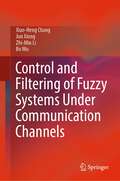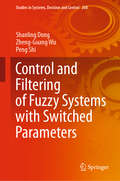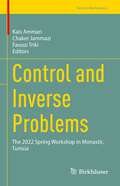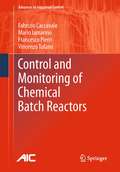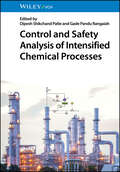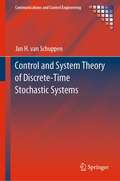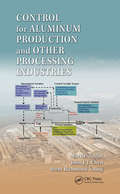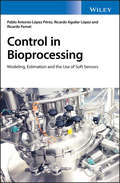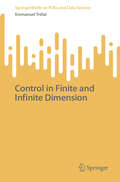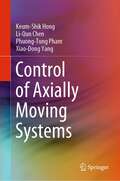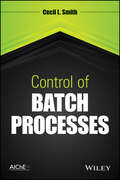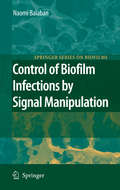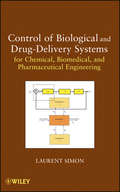- Table View
- List View
Control and Filtering of Fuzzy Systems Under Communication Channels
by Xiao-Heng Chang Bo Wu Jun Xiong Zhi-Min LiThis book systematically studies the feedback control and filtering problems for nonlinear plants with limited communication channels based on T-S fuzzy models. By fully considering different network-induced phenomena, such as signal quantizations, time-delays, data packet dropouts, communication protocols, cyber attacks, and so on, some significant strategies are provided for various performance analysis and different controller/filter synthesis of fuzzy systems. The event-triggered mechanism is also mentioned to save the communication resource. Moreover, some results are extended to the fault detection and fault-tolerant control. The book provides some new methodologies in analysis and synthesis of fuzzy systems under communication channels, and can serve as a valuable reference material for researchers wishing to explore the area of control and filtering of fuzzy systems and networked systems.
Control and Filtering of Fuzzy Systems with Switched Parameters (Studies in Systems, Decision and Control #268)
by Peng Shi Zheng-Guang Wu Shanling DongThis book presents recent advances in control and filter design for Takagi-Sugeno (T-S) fuzzy systems with switched parameters. Thanks to its powerful ability in transforming complicated nonlinear systems into a set of linear subsystems, the T-S fuzzy model has received considerable attention from those the field of control science and engineering. Typical applications of T-S fuzzy systems include communication networks, and mechanical and power electronics systems. Practical systems often experience abrupt variations in their parameters or structures due to outside disturbances or component failures, and random switching mechanisms have been used to model these stochastic changes, such as the Markov jump principle. There are three general types of controller/filter for fuzzy Markov jump systems: mode-independent, mode-dependent and asynchronous. Mode-independence does not focus on whether modes are accessible and ignores partially useful mode information, which results in some conservatism. The mode-dependent design approach relies on timely, complete and correct information regarding the mode of the studied plant. Factors like component failures and data dropouts often make it difficult to obtain exact mode messages, which further make the mode-dependent controllers/filters less useful. Recently, to overcome these issues, researchers have focused on asynchronous techniques. Asynchronous modes are accessed by observing the original systems based on certain probabilities. The book investigates the problems associated with controller/filter design for all three types. It also considers various networked constraints, such as data dropouts and time delays, and analyzes the performances of the systems based on Lyapunov function and matrix inequality techniques, including the stochastic stability, dissipativity, and $H_\infty$. The book not only shows how these approaches solve the control and filtering problems effectively, but also offers potential meaningful research directions and ideas. Covering a variety of fields, including continuous-time and discrete-time Markov processes, fuzzy systems, robust control, and filter design problems, the book is primarily intended for researchers in system and control theory, and is also a valuable reference resource for graduate and undergraduate students. Further, it provides cases of fuzzy control problems that are of interest to scientists, engineers and researchers in the field of intelligent control. Lastly it is useful for advanced courses focusing on fuzzy modeling, analysis, and control.
Control and Inverse Problems: The 2022 Spring Workshop in Monastir, Tunisia (Trends in Mathematics)
by Kaïs Ammari Chaker Jammazi Faouzi TrikiThis volume presents a timely overview of control theory and inverse problems, and highlights recent advances in these active research areas. The chapters are based on talks given at the spring school "Control & Inverse Problems” held in Monastir, Tunisia in May 2022. In addition to providing a snapshot of these two areas, chapters also highlight breakthroughs on more specific topics, such as: Controllability of dynamical systems Information transfer in multiplier equations Nonparametric instrumental regression Control of chained systems The damped wave equation Control and Inverse Problems will be a valuable resource for both established researchers as well as more junior members of the community.
Control and Monitoring of Chemical Batch Reactors (Advances in Industrial Control)
by Vincenzo Tufano Francesco Pierri Fabrizio Caccavale Mario IamarinoThe Chemical Batch Reactor is aimed at tackling the above problems from a blending of academic and industrial perspectives. Advanced solutions (i.e., those based on recent research results) to the four fundamental problems of modeling, identification, control and fault diagnosis for batch processes are developed in detail in four distinct chapters. In each chapter, a general overview of foundational concepts is also given, together with a review of recent and classical literature on the various subjects. To provide a unitary treatment of the different topics and give a firm link to the underlying practical applications, a single case study is developed as the book progresses; a batch process of industrial interest, i.e., the phenol-formaldehyde reaction for the production of phenolic resins, is adopted to test the various techniques developed. In this way, a roadmap of the solutions to fundamental problems, ranging from the early stages of the production process to the complete design of control and diagnosis systems, is provided for both industrial practitioners and academic researchers.
Control and Safety Analysis of Intensified Chemical Processes
by Gade Pandu Rangaiah Dipesh Shikchand PatleControl and Safety Analysis of Intensified Chemical Processes Resource on the control and safety analysis of intensified chemical processes, ranging from general methods to specific applications Control and Safety Analysis of Intensified Chemical Processes covers the basic principles of and recent developments in control and safety analysis of intensified chemical processes, ranging from dynamic simulations and safety analysis to the design and control of important processes. The text discusses general methods and tools such as dynamic simulation, control and safety analysis as well as design aspects and analysis of important applications in order to provide scientists and engineers with an understanding of the design, control and safety considerations involved in intensified chemical processes. Sample topics covered in Control and Safety Analysis of Intensified Chemical Processes include: Simulation and optimization methods, common programs and simulators for simulation and optimization, and interfacing of simulators and optimizers Programs/simulators for dynamic simulation and control, tuning of controllers, and popular criteria for control assessment Control of a hybrid reactive-extractive distillation systems for ternary azeotropic mixtures, reactive distillation in recycle systems, and middle vessel batch distillation with vapor recompression Safety analysis of intensified processes (e.g. extractive distillation, dividing wall column, dividing wall column with mechanical vapor recompression, and algal biodiesel process) A comprehensive resource on the subject, Control and Safety Analysis of Intensified Chemical Processes is a highly valuable reference for researchers, students and practitioners interested in process intensification and their applications. The text can be adopted by instructors for use in advanced courses on process control and safety.
Control and System Theory of Discrete-Time Stochastic Systems (Communications and Control Engineering)
by Jan H. van SchuppenThis book helps students, researchers, and practicing engineers to understand the theoretical framework of control and system theory for discrete-time stochastic systems so that they can then apply its principles to their own stochastic control systems and to the solution of control, filtering, and realization problems for such systems. Applications of the theory in the book include the control of ships, shock absorbers, traffic and communications networks, and power systems with fluctuating power flows.The focus of the book is a stochastic control system defined for a spectrum of probability distributions including Bernoulli, finite, Poisson, beta, gamma, and Gaussian distributions. The concepts of observability and controllability of a stochastic control system are defined and characterized. Each output process considered is, with respect to conditions, represented by a stochastic system called a stochastic realization. The existence of a control law is related to stochastic controllability while the existence of a filter system is related to stochastic observability. Stochastic control with partial observations is based on the existence of a stochastic realization of the filtration of the observed process.
Control for Aluminum Production and Other Processing Industries
by Mark P. Taylor John J. Chen Brent Richmond YoungAn uncomfortable observation in the Shift Logs and Process Control records of most aluminum smelting plants is that process control failures, large and small, happen every day. Although only a small fraction of these failures give rise to catastrophic events, the difference between a disaster we read about and a failure which, although expensive, h
Control in Bioprocessing: Modeling, Estimation and the Use of Soft Sensors
by Pablo A. López Pérez Ricardo Aguilar López Ricardo FematCloses the gap between bioscience and mathematics-based process engineering This book presents the most commonly employed approaches in the control of bioprocesses. It discusses the role that control theory plays in understanding the mechanisms of cellular and metabolic processes, and presents key results in various fields such as dynamic modeling, dynamic properties of bioprocess models, software sensors designed for the online estimation of parameters and state variables, and control and supervision of bioprocesses Control in Bioengineering and Bioprocessing: Modeling, Estimation and the Use of Sensors is divided into three sections. Part I, Mathematical preliminaries and overview of the control and monitoring of bioprocess, provides a general overview of the control and monitoring of bioprocesses, and introduces the mathematical framework necessary for the analysis and characterization of bioprocess dynamics. Part II, Observability and control concepts, presents the observability concepts which form the basis of design online estimation algorithms (software sensor) for bioprocesses, and reviews controllability of these concepts, including automatic feedback control systems. Part III, Software sensors and observer-based control schemes for bioprocesses, features six application cases including dynamic behavior of 3-dimensional continuous bioreactors; observability analysis applied to 2D and 3D bioreactors with inhibitory and non-inhibitory models; and regulation of a continuously stirred bioreactor via modeling error compensation. Applicable across all areas of bioprocess engineering, including food and beverages, biofuels and renewable energy, pharmaceuticals and nutraceuticals, fermentation systems, product separation technologies, wastewater and solid-waste treatment technology, and bioremediation Provides a clear explanation of the mass-balance–based mathematical modelling of bioprocesses and the main tools for its dynamic analysis Offers industry-based applications on: myco-diesel for implementing "quality" of observability; developing a virtual sensor based on the Just-In-Time Model to monitor biological control systems; and virtual sensor design for state estimation in a photocatalytic bioreactor for hydrogen production Control in Bioengineering and Bioprocessing is intended as a foundational text for graduate level students in bioengineering, as well as a reference text for researchers, engineers, and other practitioners interested in the field of estimation and control of bioprocesses.
Control in Finite and Infinite Dimension (SpringerBriefs on PDEs and Data Science)
by Emmanuel TrélatThis book is the result of various master and summer school courses the author has taught. The objective is to provide the reader with an introduction to control theory and to the main tools allowing to treat general control systems. The author hopes this book will serve as motivation to go deeper into the theory or numerical aspects that are not covered in this book. This book might be helpful for graduate students and researchers in the field of control theory.
Control of Axially Moving Systems
by Keum-Shik Hong Li-Qun Chen Phuong-Tung Pham Xiao-Dong YangThis book provides a comprehensive guideline on dynamic analysis and vibration control of axially moving systems. First, the mathematical models of various axially moving systems describing the string, beam, belt, and plate models are developed. Accordingly, dynamical issues such as the equilibrium configuration, critical velocity, stability, bifurcation, and further chaotic dynamics are analyzed. Second, this book covers the design of the control schemes based on the hitherto control strategies for axially moving systems: feedback control using the transfer function, variable structure control, control by regulating the axial velocity, wave cancellation approach, boundary control using the Lyapunov method, adaptive control, and hybrid control methods. Finally, according to the contents discussed in the book, specific aspects are outlined for initiating future research endeavors to be undertaken concerning axially moving systems. This book is useful to graduate students and researchers in industrial sectors such as continuous manufacturing systems, transport systems, power transmission systems, and lifting systems not to mention in academia.
Control of Batch Processes
by Cecil L. SmithGives a real world explanation of how to analyze and troubleshoot a process control system in a batch process plant* Explains how to analyze the requirements for controlling a batch process, develop the control logic to meet these requirements, and troubleshoot the process controls in batch processes* Presents three categories of batch processes (cyclical batch, multigrade facilities, and flexible batch) and examines the differences in the control requirements in each* Examines various concepts of a product recipe and what its nature must be in a flexible batch facility* Approaches the subject from the process perspective, with emphasis on the advantages of using structured logic in the automation of all but the simplest batch processes.* Discusses the flow of information starting at the plant floor and continuing through various levels of the control logic up to the corporate IT level
Control of Biofilm Infections by Signal Manipulation (Springer Series on Biofilms #2)
by Naomi Balaban J. W. CostertonThe number of patients affected by and dying from what can be considered as a "biofilm disease" is higher than heart disease and cancer combined. Thus, this is a hugely important work that describes the molecular mechanisms of cell-to-cell communication among bacterial cells in a biofilm, the development of antibiofilm inhibitors such as quorum-sensing inhibitors, and the use of biofilm inhibitors to prevent and treat bacterial infections in humans and other animals.
Control of Biological and Drug-Delivery Systems for Chemical, Biomedical, and Pharmaceutical Engineering
by Laurent SimonEnables readers to apply process dynamics and control theory to solve bioprocess and drug delivery problemsThe control of biological and drug delivery systems is critical to the health of millions of people worldwide. As a result, researchers in systems biology and drug delivery rely on process dynamics and control theory to build our knowledge of cell behavior and to develop more effective therapeutics, controlled release devices, and drug administration protocols to manage disease.Written by a leading expert and educator in the field, this text helps readers develop a deep understanding of process dynamics and control theory in order to analyze and solve a broad range of problems in bioprocess and drug delivery systems. For example, readers will learn how stability criteria can be used to gain new insights into the regulation of biological pathways and lung mechanics. They'll also learn how the concept of a time constant is used to capture the dynamics of diffusive processes. Readers will also master such topics as external disturbances, transfer functions, and input/output models with the support of the author's clear explanations, as well as:Detailed examples from the biological sciences and novel drug delivery technologies160 end-of-chapter problems with step-by-step solutionsDemonstrations of how computational software such as MATLAB and Mathematica solve complex drug delivery problemsControl of Biological and Drug-Delivery Systems for Chemical, Biomedical, and Pharmaceutical Engineering is written primarily for undergraduate chemical and biomedical engineering students; however, it is also recommended for students and researchers in pharmaceutical engineering, process control, and systems biology. All readers will gain a new perspective on process dynamics and control theory that will enable them to develop new and better technologies and therapeutics to treat human disease.
Control of Complex Nonlinear Systems with Delay (Springer Theses)
by Philipp HövelThis research addresses delay effects in nonlinear systems, which are ubiquitous in various fields of physics, chemistry, biology, engineering, and even in social and economic systems. They may arise as a result of processing times or due to the finite propagation speed of information between the constituents of a complex system. Time delay has two complementary, counterintuitive and almost contradictory facets. On the one hand, delay is able to induce instabilities, bifurcations of periodic and more complicated orbits, multi-stability and chaotic motion. On the other hand, it can suppress instabilities, stabilize unstable stationary or periodic states and may control complex chaotic dynamics. This thesis deals with both aspects, and presents novel fundamental results on the controllability of nonlinear dynamics by time-delayed feedback, as well as applications to lasers, hybrid-mechanical systems, and coupled neural systems.
Control of Crop Diseases
by W. R. Carlile A. CoulesThoroughly revised and updated to reflect current and emerging practices, this book explores modern methods of disease control in field and glasshouse crops. It outlines the major crop diseases, with a particular emphasis on those features of symptomology and life cycle that are most relevant to the development of control measures. Modern diagnostic techniques are considered, focusing on developments in nucleic acid and immunological based procedures and their use in plant quarantine and certification schemes. The potential impact of these advances in molecular technology on plant breeding and disease resistance is also covered. Fungicides are a central part of disease control in the EU and, as such, a comprehensive account of their use forms an important part of the text, along with strategies to minimise the incidence of fungicide resistance in pathogen populations. Looking to the future, the book also addresses legislative, environmental and food safety concerns.
Control of Discrete-Time Descriptor Systems: An Anisotropy-based Approach (Studies In Systems, Decision And Control #157)
by Alexey A. Belov Olga G. Andrianova Alexander P. KurdyukovControl of Discrete-Time Descriptor Systems takes an anisotropy-based approach to the explanation of random input disturbance with an information-theoretic representation. It describes the random input signal more precisely, and the anisotropic norm minimization included in the book enables readers to tune their controllers better through the mathematical methods provided. The book contains numerous examples of practical applications of descriptor systems in various fields, from robotics to economics, and presents an information-theoretic approach to the mathematical description of coloured noise. Anisotropy-based analysis and design for descriptor systems is supplied along with proofs of basic statements, which help readers to understand the algorithms proposed, and to undertake their own numerical simulations. This book serves as a source of ideas for academic researchers and postgraduate students working in the control of discrete-time systems. The control design procedures outlined are numerically effective and easily implementable in MATLAB®
Control of Foodborne Microorganisms
by Vijay K. Juneja John N. SofosPresents the latest research in the control of foodborne pathogens. Emphasizes traditional and emerging techniques as well as current applications for the inactivation of microorganisms to reduce illness and enhance food safety and quality.
Control of Fuel Combustion in Boilers (Studies in Systems, Decision and Control #287)
by Artur O. ZaporozhetsThis book examines key issues in improving the efficiency of small and medium power boiler units by adding control systems for the fuel combustion process. The original models, algorithms, software and hardware of the system developed for controlling the fuel combustion process are presented. In turn, the book presents a methodology for assessing the influence of climatic factors on the combustion process, and proposes new methods for measuring the thermophysical characteristics, which require taking into account the concentration of oxygen in the air. The system developed here was implemented on a boiler of the NIISTU-5 type, which is widely used for heat power engineering in Ukraine and other Eastern European countries. Given its scope, the book offers a valuable asset for researchers and engineers, as well as lecturers and graduate students at higher education institutions dealing with heat engineering equipment.
Control of Heavy Metals in the Environment: Recent Advances in Metal Toxicity, Pollution Control, and Remediation Techniques (Advances in Industrial and Hazardous Wastes Treatment)
by Lawrence K. Wang Yung-Tse Hung Wang, Mu-Hao Sung J. Paul ChenOffering broad coverage of advanced principals and applications, Control of Heavy Metals in the Environment series provides chemical and environmental engineers with the most complete resource available on the treatment of heavy metal contaminants with an emphasis on advanced and alternative approaches. It investigates a variety of environmental pollution sources and waste characteristics that require a multitude of remediation methods. It covers metal oxide nanoparticle pollution and nanotechnology applications for remediation. The authors delve into costs and effluent standards and offer several illustrative case histories to illustrate the regional and global effects of key pollution control practices.Features: Provides technical information for industrial and hazardous waste treatment. Explores the newest methods of clean production and waste minimization. Covers topics related to environmental geochemistry. Includes numerous figures, tables, examples, and case histories.
Control of Innate and Adaptive Immune Responses during Infectious Diseases
by Julio AlibertiUpon infection the host needs to mount vigorous immune response against pathogen in order to successfully control its replication. However, once the infectious agent is controlled or eliminated, host cells need to signal the immune system to slow or cease its activities. While vast knowledge has been accumulated through the years on the mechanisms involved in the initiation and effector phases of the immune responses, the pathways triggered in order to modulate or end innate and acquired immunity are becoming more evident as evidence for its relevance comes to surface. Due to its biological power, evidence has surfaced indicating that eventually pathogens may take advantage of such regulatory pathways in order to escape effector mechanisms and progress to persistence. This book will discuss several cellular pathways involved in controlling immune response in the context of infectious diseases, their biological consequences and potential "hijack" of these pathways for the benefit of pathogen leading towards pathogen persistence as opposed to clearance.
Control of Integral Processes with Dead Time (Advances in Industrial Control)
by Antonio Visioli Qingchang ZhongControl of Integral Processes with Dead Time provides a unified and coherent review of the various approaches devised for the control of integral processes, addressing the problem from different standpoints. In particular, the book treats the following topics: How to tune a PID controller and assess its performance; How to design a two-degree-of-freedom control scheme in order to deal with both the set-point following and load disturbance rejection tasks; How to modify the basic Smith predictor control scheme in order to cope with the presence of an integrator in the process; and how to address the presence of large process dead times. The methods are presented sequentially, highlighting the evolution of their rationale and implementation and thus clearly characterising them from both academic and industrial perspectives.
Control of Large Wind Energy Systems: Theory and Methods for the User (Advances in Industrial Control)
by Adrian GambierWind energy systems are central contributors to renewable energy generation, and their technology is continuously improved and updated. Without losing sight of theory, Control of Large Wind Energy Systems demonstrates how to implement concrete control systems for modern wind turbines, explaining the reasons behind choices and decisions. This book provides an extended treatment of different control topics divided into three thematic parts including modelling, control and implementation. Solutions for real-life difficulties such as multi-parameter tuning of several controllers, curve fitting of nonlinear power curves, and filter design for concrete signals are also undertaken. Examples and a case study are included to illustrate the parametrization of models, the control systems design with problems and possible solutions. Advice for the selection of control laws, calculation of specific parameters, which are necessary for the control laws, as the sensitivity functions, is given, as well as an evaluation of control performance based on indices and load calculation. Control of Large Wind Energy Systems covers methodologies which are not usually found in literature on this topic, including fractional order PID and nonlinear PID for pitch control, peak shaving control and extremum seeking control for the generator control, yaw control and shutdown control. This makes it an ideal book for postgraduate students, researchers and industrial engineers in the field of wind turbine control. Advances in Industrial Control reports and encourages the transfer of technology in control engineering. The rapid development of control technology has an impact on all areas of the control discipline. The series offers an opportunity for researchers to present an extended exposition of new work in all aspects of industrial control.
Control of Linear Parameter Varying Systems with Applications
by Carsten W. Scherer Javad MohammadpourControl of Linear Parameter Varying Systems compiles state-of-the-art contributions on novel analytical and computational methods for addressing system identification, model reduction, performance analysis and feedback control design and addresses address theoretical developments, novel computational approaches and illustrative applications to various fields. Part I discusses modeling and system identification of linear parameter varying systems, Part II covers the importance of analysis and control design when working with linear parameter varying systems (LPVS) , Finally, Part III presents an applications based approach to linear parameter varying systems, including modeling of a turbocharged diesel engines, Multivariable control of wind turbines, modeling and control of aircraft engines, control of an autonomous underwater vehicles and analysis and synthesis of re-entry vehicles.
Control of Magnetotransport in Quantum Billiards: Theory, Computation and Applications (Lecture Notes in Physics #927)
by Christian V. Morfonios Peter SchmelcherIn this book the coherent quantum transport of electrons through two-dimensional mesoscopic structures is explored in dependence of the interplay between the confining geometry and the impact of applied magnetic fields, aiming at conductance controllability. After a top-down, insightful presentation of the elements of mesoscopic devices and transport theory, a computational technique which treats multiterminal structures of arbitrary geometry and topology is developed. The method relies on the modular assembly of the electronic propagators of subsystems which are inter- or intra-connected providing large flexibility in system setups combined with high computational efficiency. Conductance control is first demonstrated for elongated quantum billiards and arrays thereof where a weak magnetic field tunes the current by phase modulation of interfering lead-coupled states geometrically separated from confined states. Soft-wall potentials are then employed for efficient and robust conductance switching by isolating energy persistent, collimated or magnetically deflected electron paths from Fano resonances. In a multiterminal configuration, the guiding and focusing property of curved boundary sections enables magnetically controlled directional transport with input electron waves flowing exclusively to selected outputs. Together with a comprehensive analysis of characteristic transport features and spatial distributions of scattering states, the results demonstrate the geometrically assisted design of magnetoconductance control elements in the linear response regime.
Control of Noise and Structural Vibration: A MATLAB®-Based Approach
by Qibo Mao Stanislaw PietrzkoControl of Noise and Structural Vibration presents a MATLAB®-based approach to solving the problems of undesirable noise generation and transmission by structures and of undesirable vibration within structures in response to environmental or operational forces. The fundamentals of acoustics, vibration and coupling between vibrating structures and the sound fields they generate are introduced including a discussion of the finite element method for vibration analysis. Following this, the treatment of sound and vibration control begins, illustrated by example systems such as beams, plates and double walls. Sensor and actuator placement is explained as is the idea of modal sensor-actuators. The design of appropriate feedback systems includes consideration of basic stability criteria and robust active structural acoustic control. Positive position feedback (PPF) and multimode control are also described in the context of loudspeaker-duct and loudspeaker-microphone models. The design of various components is detailed including the analog circuit for PPF, adaptive (semi-active) Helmholtz resonators and shunt piezoelectric circuits for noise and vibration suppression. The text makes extensive use of MATLAB® examples and these can be simulated using files available for download from the book's webpage at springer.com. End-of-chapter exercises will help readers to assimilate the material as they progress through the book. Control of Noise and Structural Vibration will be of considerable interest to the student of vibration and noise control and also to academic researchers working in the field. It's tutorial features will help practitioners who wish to update their knowledge with self-study.
